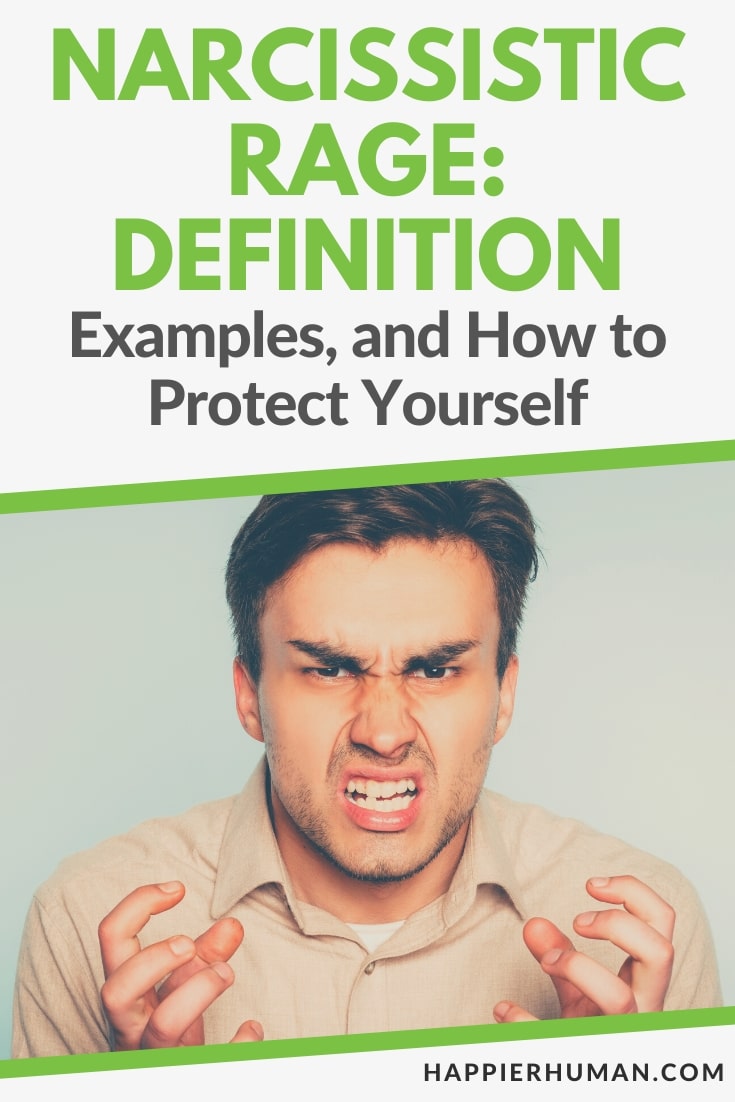There might be affiliate links on this page, which means we get a small commission of anything you buy. As an Amazon Associate we earn from qualifying purchases. Please do your own research before making any online purchase.
Narcissist rage is something you’re going to experience at some point when dealing with a narcissist in your close circle. You won’t miss it. Rage is usually marked by explosive anger/rage or passive anger/rage when they can’t get their way.
The response is typically disproportionate to the situation. Being confronted with such behavior can be scary, especially if you're caught by surprise.
A narcissist typically exhibits narcissistic rage after the love-bombing or honeymoon phase of getting acquainted. They normally start showing their negative traits once they believe they have you in their grip.
They may show passive-aggressive anger earlier on, but you may not know it’s a subtle form of narcissistic rage. The signs may become clearer once you go over the narcissist rage examples below.
So why do narcissists react this way? We will take a look at the reasons for their tantrums.
Overall, the behavior is difficult to deal with and tends to strain relationships. Since you’re already entangled with the individual, you will need an action plan for managing the negative response when things don’t go their way.
The plan outlined below can work for those dating, living with, or working with a narcissist.
What Is Narcissistic Rage?
“Narcissistic rage can be defined as intense anger, aggression, or passive-aggression when a narcissist experiences a setback.” This is according to Psychology Today. Typically, it’s a negative experience that makes them feel inadequate or vulnerable.
The negative reaction is usually uncontrollable and disproportionate to the thing that triggers it.
The term narcissistic rage was first coined by psychoanalyst Heinz Kohut’ His work in self-psychology addressed this type of dysregulated behavior by those with narcissistic personality disorder (NPD).
When triggered, they seek vengeance against the person they perceive is responsible for triggering their rage. Usually, they won’t stop until they feel vindicated or the wrongdoing, real or perceived, ceases to affect their injured ego.
NPD is a mental health condition that affects an estimated 6 percent of the US adult population. However, 6 percent may not be a true reflection of the total percentage of those with narcissistic personalities.
Narcissists believe nothing is wrong with them and rarely seek a mental health evaluation or therapy.
Narcissistic Personality Traits
People with NPD display a pattern of identifiable traits including a lack of empathy, grandiosity (inflated self-importance), and excessive need for admiration.
These are three of the nine traits set out in a manual used by psychiatrists for determining if someone has NPD. Self-reflection and behavior correction are difficult for a narcissist due to the other six maladaptive traits.
Learn 20 Warning Signs you’re dating a Narcissist.
What Causes Narcissistic Rage?
Rage is a negative reaction and is a part of their coping mechanism. Based on a general consensus by psychologists, the response stems from an inability to control feelings regarding real or perceived negative experiences.
One example is their use of destructive anger to deflect from a topic or situation that generates feelings of inferiority or injures their ego.
Narcissists are fragile at the core, regardless of what persona they present to you. Psychologists point out that low self-esteem and self-worth are largely at the root of narcissistic rage. For those reasons, they would go to lengths to avoid anything that conflicts with their self-image or wounds their ego.
According to Kohut, a narcissist’s traits work in favor and against them. He stated that the individual goes back and forth between overestimating their self-importance and feeling inferior or inadequate.
The lack of a stable self-image causes them to rely on others to regulate their self-esteem and self-value. In the same vein, doing anything that threatens their self-image can result in unwarranted and often disproportionate anger.
Keep in mind that a narcissist can rage internally, and will do things healthy, self-secure individuals won’t. Examples of quiet rage include passive aggression, stonewalling, withholding, and silent treatment.

While everyone gets angry, narcissists take steps to get back at you in some way, shape, or form. This is a reflection of a lack of self-control.
They typically only feel better once they retaliate, usually in a way that hurts your feelings. In extreme cases, narcissistic rage can result in harm to the person on the receiving end.
The fact that they can engage in visible or silent aggression, and not only to actual but also perceived threats to their self-image, is concerning.
Narcissistic Rage Examples
What better way is there to get a grasp of what a narcissistic tantrum looks like than through real-life examples? I’ve provided examples below in anticipation of readers wanting to know how to spot when a narcissist shifts to their dark side.
Awareness of the signs puts you in control in terms of what to expect and how to maneuver away to protect yourself. The examples below reflect examples of both outward and passive rage.
- Disproportionate anger: E.g., breaking all the drinking glasses in a set because one broke
- Screaming and yelling to overpower you and regain control
- Destroying your property as a way of vindicating a wrong against them
- Belittling or humiliating their partner for highlighting their shortcomings
- Refusing to speak (silent treatment) to the person they perceive injured their self-image
- Withholding affection or necessary resources, such as money, as a way to exact punishment
- Passive aggression, e.g., harboring resentment, ‘dragging their feet’ on chores, refusing to cooperate, or sabotage
Even positive feedback can be taken as criticism, shatter their perceived self-importance, and activate narcissistic rage.
Narcissistic Rage Triggers to Know
Anything that causes a narcissistic injury or a narcissistic wound is enough to push a narcissist over the edge. A narcissistic wound is anything that crushes their ego, perceived self-importance, or sense of entitlement.
Narcissists also generally get triggered whenever their needs go unmet. The need could be a basic human need, such as money or sex, or one that strokes their ego. Ego-boosting needs include attention, admiration, compliments, and validation.
To be more specific, they may lash out, for any of the following reasons:
- Criticism
- Rejection
- Humiliation
- Betrayal
- Shame
- Setback, disappointment, or failure
- Holding a different opinion
- Challenging their narrative
- Losing control over matters
- Being ignored
- Being made to feel inferior
- Exposing their flaws or narcissistic traits
The exact triggers tend to be different depending on the type of narcissist in your life. Grandiose (open) narcissists, for example, swear by their self-importance. They come across as confident and arrogant. Yet, they can get triggered.
Vulnerable (undercover) narcissists are more passive in their everyday dealings with people. They take on the persona to hide their toxic traits. However, their unhealthy behavior is exhibited when they are triggered.
Whether it is uncontrollable outbursts or silent anger, they will react when triggered. Increased anger occurs in episodes, but there’s no predictable timeline as to the exact date or time. In short, the trigger is anything that causes them to lose emotional control.
They may be more susceptible to becoming enraged if they are mentally stressed, frustrated, or anxious. That's according to Nakpongi Thomas, PhD, LPC, a Licensed Professional Counselor. Thomas explains that narcissist rage occurs in a cycle.
Rage is the last stage in the cycle of experiencing the outlined negative emotions. At this stage, they lose their temper, throw a fit, or show visible signs of aggression.
The angry outbursts can range from mild irritation to violent attacks when measured on the narcissistic rage spectrum.
How to Handle Narcissistic Rage and Protect Yourself
Being around a narcissistic person can be an unpleasant experience. Their toxic behavior can impact your mental health over time. Challenge yourself to not sit back and allow them to get away with unruly behaviors.
It doesn’t mean you have to go toe-to-toe with them. There are subtle or more charismatic ways to handle a narcissist without escalating the situation. A delicate hand is required, so as not to trigger them more or intensify their anger.
Outlined below is a brief action plan for dealing with narcissistic rage from a loved one and maintaining your safety. Before you dive in, keep these things in mind.
1. Keep calm and carry on
You may be tempted to assert yourself and candidly make your feelings known. Peaceful dialogue is hardly possible when a narcissist is at the height of a temper tantrum.
Biting your tongue sometimes has a greater effect on maintaining peace. The instant situation might be one of those times to enforce silence. Dialogue can come later when the narcissist returns to a calm state.
2. Shift your focus inward
In times of conflict, we all need something to restore our inner balance and help us get through it. Consider things like breathing exercises and meditation to help reduce stress and calm your mind.
These two self-care exercises provide a way to detach from the toxic drama and find peace from within. Some individuals find journaling particularly helpful, as it allows them to explore their thoughts and feelings privately.
3. Familiarize yourself with their triggers
Studying someone’s behavior and trying to understand the why behind it is a good starting point.
The knowledge is key to deciding what strategies may work best to cope. For example, how and when to interact, respond, or keep away.

I’ve already provided a list of potential triggers above. Some may apply to the person you’re dealing with. It’s stressful to have to “walk on eggshells” around a narcissist.
However, knowing what sets them off means you can adjust your approach to protect your well-being.
4. Be mindful not to push their buttons
A rule of thumb is to immediately ease on anything that’s making them angry. Your sense of awareness will come into play here. Even if you know they’re in the wrong, erring on the side of caution can help keep you emotionally or physically safe.
While the typical narcissist behavior aligns more with emotional abuse, some can get physically violent. For example, a narcissist who also shares traits of a sociopath, also called a narcissistic sociopath.
5. Give them time to cool off
While narcissists can become furious or resentful, it doesn’t last forever. They eventually cool down and regroup.
The timeline is different from person to person. Allow them time and space to calm down as a part of your self-care. Trying to intervene, ask questions, or offer help may anger them more.
Leave them alone and let them reinitiate interaction. They usually do so sooner than you think, especially if they perceive you aren’t paying them any attention. Remember getting your attention makes narcissists feel important.
6. Explain what you’ve observed
Narcissists are not famous for having a high level of emotional intelligence or self-awareness, even though many of them are brilliant and successful. Their loved ones often have to highlight their misconduct. Even then, they may refuse to take accountability.
Regardless, you owe it to yourself to point out the behavior. It may be helpful to itemize each one of their reactions and the scenarios that trigger it. Be mindful not to accuse them of demonstrating narcissistic rage.
7. Ask how you can help
Narcissists lack empathy, but it doesn’t mean you should treat them unempathetically. Be the bigger person. Ask them if there’s anything you can do to lessen the tension.
While you’re not in control of their response, how you interact can help minimize negative reactions. Learning their triggers is great, but hearing directly from them can provide more clarity on how to interact with them moving forward.
8. Offer validation where appropriate
It’s easy to tell someone they’re wrong and close yourself off from positive dialogue. The situation is already somewhat fragile here.
It won’t take anything from you to listen to their point of view. Listening is one way to demonstrate empathy. You may learn something about yourself you didn’t realize that sets off the narcissists.
A safe starting point is letting them explain what’s affecting them. It’s okay to say something like, “I can see why you feel that way.” I’ve noticed that showing empathy can appease some types of narcissists, at least in my experience.
9. Remember it is not your fault
Trying to determine if your actions unintentionally contribute to narcissistic rage doesn’t mean you’re at fault.
You aren’t responsible for how the person reacts largely due to a failure to develop emotion regulation skills. However, a self-check shows emotional maturity on your part.
The narcissist may point out a particular action or response coming from you. With self-introspection, you may realize you could’ve addressed a matter with the person differently.
All of this is part of emotional intelligence and self-awareness and an indication of your level of maturity.
10. Express how you feel
Let them know raging at you is not okay and is straining your relationship. I recommend taking this step assertively to avoid coming across as a victim.
Narcissists feel powerful when their attitudes affect your emotions negatively, and will take advantage of any sign of weakness.
Hopefully, they care enough to take responsibility now that you’ve called them out. Even though they are generally highly sensitive to feedback, the narcissist in your life may be willing to adjust their reaction when in distress.
11. Physically distance yourself
Certain circumstances will call for removing yourself from the presence of the narcissist. This is a personal judgment call. Example scenarios include if they are yelling or screaming or you sense a threat of physical harm.
Now might be the perfect time to leave the room, or walk away if they’re raging in public. Just a quick note, yelling at you is a form of emotional abuse and can leave you feeling belittled, scared, or overwhelmed.
Tolerating the behavior can impact your mental health in the long term.
12. Enforce your limits
Narcissistic rage is not acceptable even if you love the person. Determine your limits as far as what conduct you will tolerate. Communicate your boundaries.
Let them know the consequences that will follow if they push past your limits. As always, express yourself in a calm but assertive tone. Follow through with consequences in case of a breach.
13. Ask them to consider couples therapy
Ask if they wish to go to therapy with you to help improve the situation. Note that agreeing to therapy requires them to take accountability and have a desire to improve their behavior.

Therapy can also be beneficial if they grow in self-awareness and emotional maturity. I would say therapists find narcissists difficult to deal with, especially those who are antagonistic, argumentative, arrogant, or combative.
14. Consider ending the relationship
Narcissistic personalities wear you down emotionally. At some point, you may need to do a relationship inventory to determine if your relationship is more hurtful than helpful. If you’ve tried all the steps to rectify the problem, maybe the relationship won’t work out.
Definitely consider quitting if they harmed or threatened to harm you. You may speak with the Domestic Violence Hotline in their absence. The Hotline provides resources for staying safe and making a safe transition out of the relationship.
Narcissistic Rage in the Workplace
In the case of narcissistic rage from your boss or coworker, there’s an equal need to maintain your safety. Taking certain steps in response can help to de-escalate the situation. Those steps include:
- bringing the behavior to their attention
- asking them to refrain from repeating the behavior
- reporting to your boss or human resources
- requesting a transfer to another department
The protective measure chosen will depend on the severity of the narcissist’s conduct or how unsafe you feel.
Final Thoughts on Narcissistic Rage
Frankly speaking, I wouldn’t tolerate uncontrollable anger in my space. Self-care and self-compassion require us to always seek healthy interactions and relationships.
Unfortunately, things can be a bit trickier to navigate if the narcissist is a family member, spouse, boss, or co-worker. Still, apply the steps and determine when you’ve had enough. What’s key is remaining calm and grounded instead of reacting.
Explore the idea of talking to a counselor or therapist if you have trouble coping. Mental health professionals are trained to provide tools to help you assess the situation and cope.
Ready to remove the person from your life? Explore 11 Effective Steps for Going No Contact with a Narcissist.
And if you're looking for articles about narcissists and narcissism, be sure to check out these blog posts:
- 7 Anger Issues Symptoms & Warning Signs
- 9 Toxic Deflection Tactics Used by Narcissists
- 10 Types of Toxic People to Avoid at All Costs
- 13 Narcissist Traits, Characteristics, & Warning Signs
- 7 Narcissistic Relationship Patterns and Warning Signs
- 5 Stages of Healing & Recovery After Narcissistic Abuse
- Overt Narcissist: Signs, Examples, and How to Deal with One
Finally, if you want to identify YOUR personality type, then take one of these 11 personality tests to better understand what makes you tick.


